The Perfect Mt. Fuji & Fuji Five Lakes Itinerary
The Fuji Five Lakes area in Japan is one of the most iconic places to visit due to, as the name of this itinerary suggests, the iconic Mt. Fuji. But, in addition to viewing Mt. Fuji, there are a lot of things to do in this beautiful Fuji area. In our Fuji Five Lakes itinerary, we will cover several attractions to enjoy as well as other helpful information to make the most of your stay in Fuji!
Where is the Fuji Five Lakes Area?
The Fuji Five Lakes area is located at the base of Mount Fuji, Japan. As the name of the area suggests, it is comprised of five different lakes. The two main cities to visit in this area are Kawaguchiko and Fujinomiya, we’ll cover attractions in both of these cities.
When to Visit Fuji
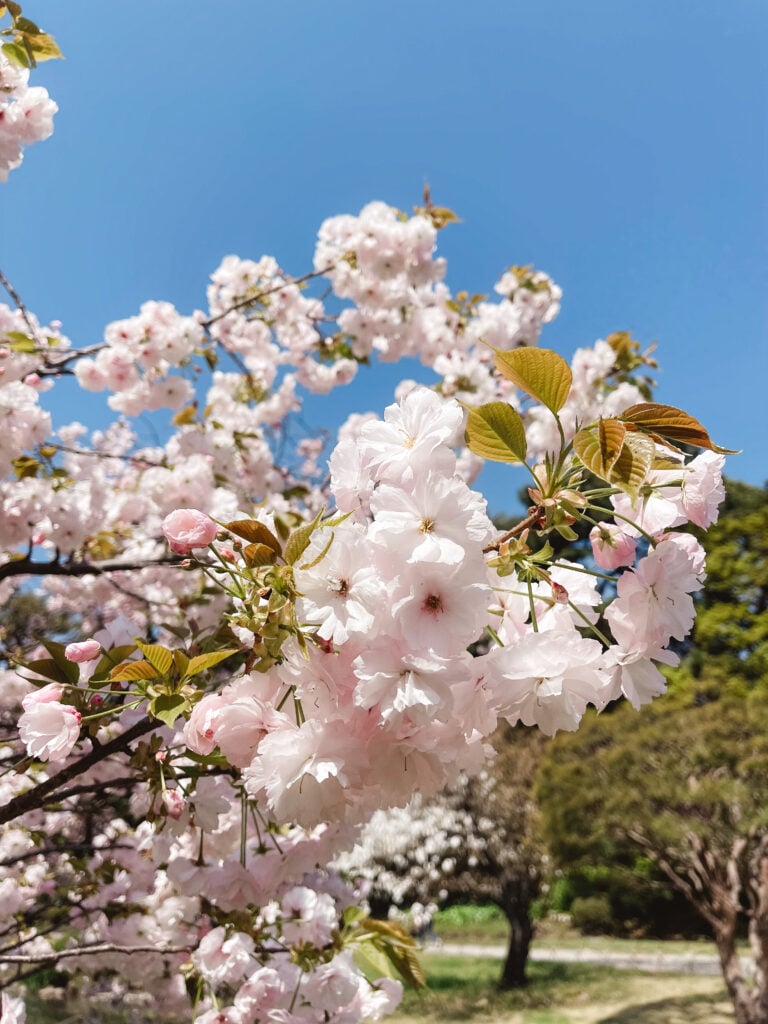
The best time to visit the Fuji Five Lakes area is during the spring for sakura season or between October and February for the best possible Fuji viewing time. On our first visit to Mt. Fuji, we went in the middle of the summer because we planned to hike the mountain. Unfortunately, summer is the WORST possible viewing time for Mt. Fuji but that’s when prime Fuji climbing season is.
I will say, after visiting during the summer I was pleasantly surprised by the milder temperatures in the area while in other parts of Japan, we were seemingly melting away. We also found that if you want to see Mt. Fuji in the summer, the best times of day are sunrise and shortly after sunset. You won’t be able to see the snowcap on the mountain, it is summer after all, but it’s still a sight to behold!
On our next trip, we visited the Fuji Five Lakes area in late November which was chilly but perfect for seeing Mt. Fuji and enjoying some of the local cuisine and onsen. After visiting now in the spring, summer, and fall I can confidently say autumn is my favorite time there but truly you can enjoy Mt. Fuji any time of the year!
How To Get To The Fuji Five Lakes Area
Traveling to Fuji from Tokyo
Traveling by Bus to Mt. Fuji
From Tokyo Station (Yaesu South Exit) there are 1-2 direct buses an hour to Kawaguchiko Station. These are operated by Fujikyu and JR Kanto Bus. The journey takes around 2 hours and costs 2,060 yen one-way.
From Shinjuku Station (Shinjuku Bus Terminal), there are two buses an hour to Kawaguchiko Station, Fujikyu and Keio Bus. The journey takes about 2 hours total and costs 2,200 yen one-way (or 2,000 yen if purchased in advance online). These buses stop at Fujisan Station and Fuji Q Highland before making a stop at Kawaguchiko Station. They also have a stop at Lake Yamanakako after Kawaguchiko.
From Shibuya Station (Mark City), there is Fujikyu operates one direct bus that departs every two hours to Kawaguchiko Station. Along the way, this bus makes stops at Fuji Q Highland, Kawaguchiko Station, and Fujisan Station. The journey takes about 2-2.5 hours total and costs 2,100 yen one-way.
Regardless of which bus you take, make sure you book advanced reservations through Willer and Japan Bus Online. These buses are not covered by the JR Pass.
Traveling by Train to Mt. Fuji
From Shinjuku Station take the JR Chuo Line to Otsuki Station which takes around 1 hour 15 minutes and costs 2,360 yen one-way for the express train or around 1 hour 40 minutes and costs 1,340 yen by local trains with one transfer. From Otsuki Station take the Fujikyu Railway Line to Kawaguchiko Station which takes around 55 minutes and costs 1,170 yen one-way.
To have fewer transfers you can also take the new Fuji Excursion Train which is a direct limited express train that currently operates 3-4 times a day from Shinjuku Station to Kawaguchiko Station with a few stops along the way. It offers sensational views and easy travel for those wanting to visit Mt. Fuji. This journey takes 2 hours and costs around 4,000 yen one-way. It is important to note that seat reservations are mandatory on this train.
Traveling to Fuji from Hakone
Tokyo is the easiest city to get to Fuji. However, if you are visiting Fuji from Hakone several buses travel between these two popular areas. From Hakone, you would take the Hakone Tozan Bus to Gotemba Station. If you have some time to kill, I highly recommend shopping at the Gotemba Outlet! It has a large variety of stores including many high-end brands. Then take the Fujikyu bus from Gotemba Station to Kawaguchiko. The entire journey takes approximately 1 hour and 20 minutes.
Tourist Passes for the Fuji Five Likes
Fuji Hakone Pass
If you are planning to visit Mt. Fuji and Hakone the Fuji Hakone Pass is a great option for travelers. It covers transportation from Tokyo to both Mt. Fuji and Hakone and transportation within Fuji and Hakone on all buses, trains, ropeways, and boats within 3 consecutive days. It also offers several discounts on attractions, restaurants, and shops within both areas. The pass costs 9,340 yen for adults and 2,850 yen for children.
Fujisan Fujigoko Passport
If you are planning to only visit Mt. Fuji the Fujisan Fujigoko Passport provides unlimited use of the Fujikyu buses, Omni buses, and Fujikko buses around the Fuji Five Likes area. The pass is sold at the Fujikyu ticket counters at Fujisan, Kawaguchiko, Mishima, Fujinomiya, and Gotemba Stations. It is also available at the Asashigaoke Yamanakako bus stop.
There are two versions of this pass available one that only includes trains between Kawaguchiko and Shimoyoshida Stations (3,300 yen for 2 days) or one that includes the entire Fujikyu railway line (4,700 yen for 2 days).
Transportation in Fuji Five Lakes
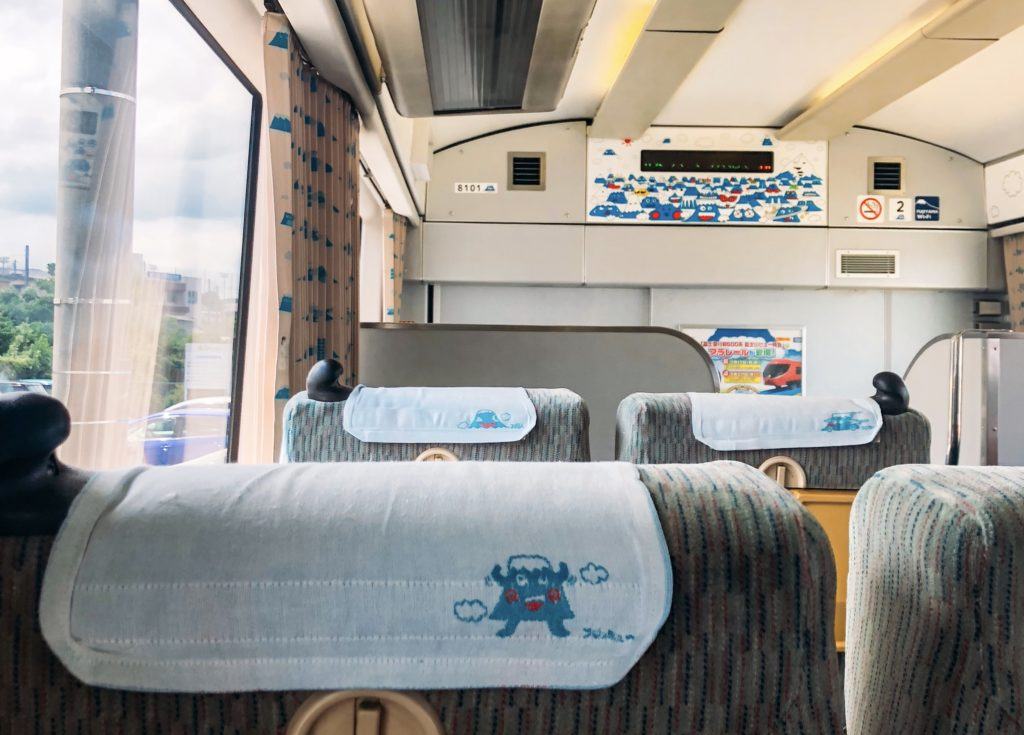
Trains in Fuji Five Lakes
The two main stations to utilize for your Fuji Five Lakes itinerary are Kawaguchiko Station and Fujisan Station which run along the Fujikyu Railway Line. Although the train will take you between the two stations it won’t take you to many of the places on this Mt. Fuji itinerary so you will have to utilize one of the other modes of transportation below!
Buses in Fuji Five Lakes
Omni Buses
The Omni Buses are the most convenient way to travel around the Fuji Five Lakes area without a car. From Kawaguchiko Station three lines of Omni buses take you to various places in the area.
Bus Pass: 1,700 yen for a 2-day unlimited pass
Omni Bus Lines
| Red Line (Lake Kawaguchi) | Runs every 15 minutes | Eastern and northern shores of Lake Kawaguchiko |
| Green Line (Saiko Line) | Runs every hour | The southern shore of Lake Kawaguchiko and around Lake Saiko |
| Blue Line (Narusawa Shojiko Motosuko Line) | Runs every 2 hours | Lake Shojiko and Lake Motosuko |
Fujikko Bus
The Fujikko Bus runs every hour between Kawaguchiko, Fujiyoshida, Oshino Village, and around Lake Yamanakako.
Bus Pass: 1,700 yen for a 2-day unlimited pass
Mount Fuji World Heritage Loop Bus
This bus loops from Kawaguchiko Station to a few tourist sites in the Fuji Five Lakes area including the infamous Chureito Pagoda.
Bus Pass: 1,050 yen for a 2-day unlimited pass
Rental Car in Fuji Five Lakes
Another way to get around for your Fuji Five Lakes itinerary is by rental car. On our first trip to the Fuji Five Lakes, we took the highway bus from Hakone and traveled around on the Omni Bus. But on our other trips to Mt. Fuji we decided to rent a car which allowed us to visit more areas. Parking wasn’t an issue in most areas but if you are traveling at a busy time like sakura season you may have more difficulty. Regardless, if you are comfortable driving in Japan this is one of the best ways to get around Mt. Fuji!
Where To Stay in the Fuji Five Lakes Area
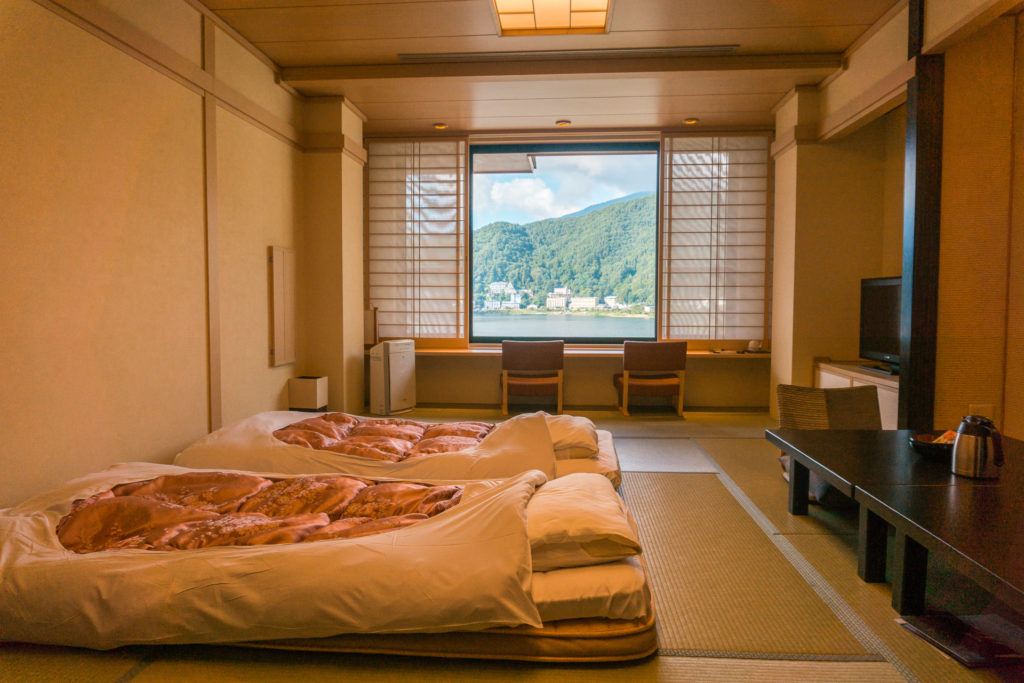
When visiting Mount Fuji I recommend staying in either Kawaguchiko or Fujinomiya for ease of access to the main things to do in the Fuji Five Lakes area. We’ve stayed in a few hotels in the Fuji area but these are our favorites:
Konansou
The first place we stayed for our Mt. Fuji itinerary was Konansou. Konansou is a luxury ryokan in Kawaguchiko. We opted to stay in one of their Lake View rooms instead of the Mt. Fuji view room because it was slightly less expensive and since we traveled to Fuji during the summer there was limited visibility to see Fuji-san. However, if we had been traveling during prime viewing time, we definitely would have splurged a bit more for a Mt. Fuji view room.
Although Konansou has rooms with private onsen, we stayed in a room without a private onsen and booked a visit to the private onsen in the hotel. From the private onsen, we were able to catch a glimpse of Fuji!
Hotel Kaneyamaen
On our most recent trip to the Fuji Five Lakes, we stayed at Hotel Kaneyamaen and I can’t say enough wonderful things about this ryokan hotel! First off the service is impeccable. From the moment you arrive, you’ll feel like you are a cherished guest as the staff takes their time to explain the hotel amenities to you.
Speaking of amenities Hotel Kaneyamaen has two terrific public onsen for their guests to utilize. The first is located on the first floor of the hotel and the other is located on the rooftop and has the most spectacular views of Mt. Fuji! Included with your stay is access to the Wine Bar where you can enjoy unlimited tastings of wine from the Yamanashi Prefecture alongside light snacks and sweets. If you aren’t interested in wine they also have beer on tap or fruit juices. Again, this is all included with your stay!
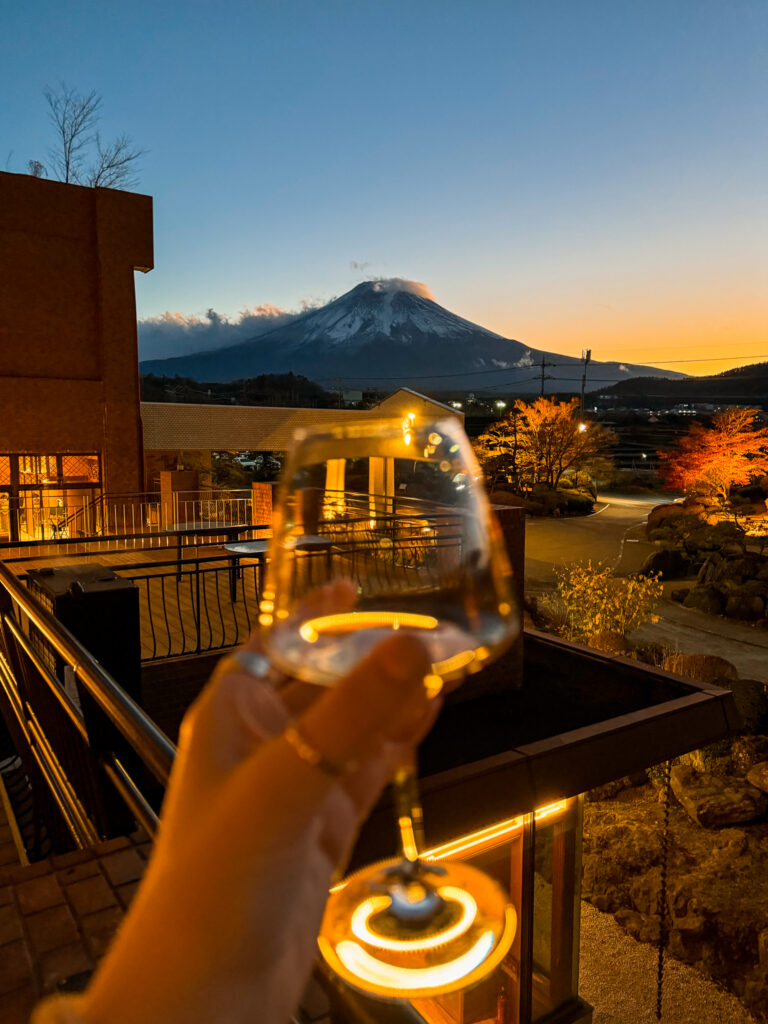
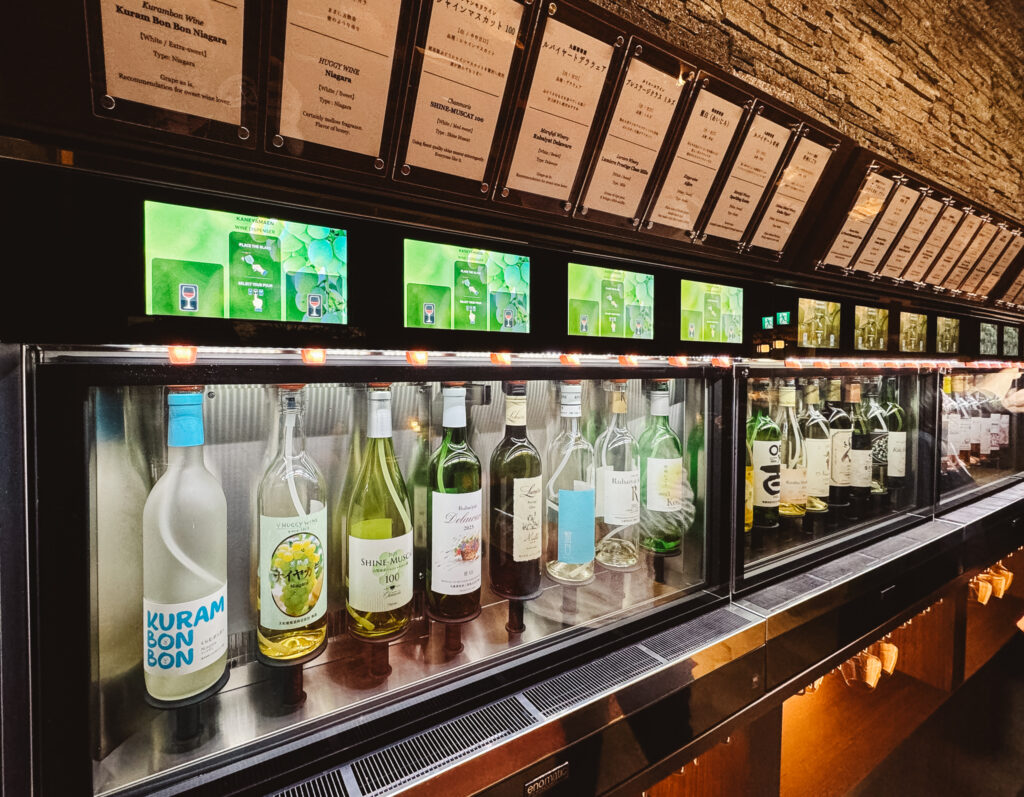
In the lobby, there is a nightly taiko drumming show which is a lively, interactive performance put on by terrific musicians! The performance is followed by bingo where you can win prizes such as luxury hotel pillows, local sake, wine, and sweets. After bingo, there is a nightly piano performance held in the whiskey bar where you can enjoy sipping on Japanese whiskey while listening to music.
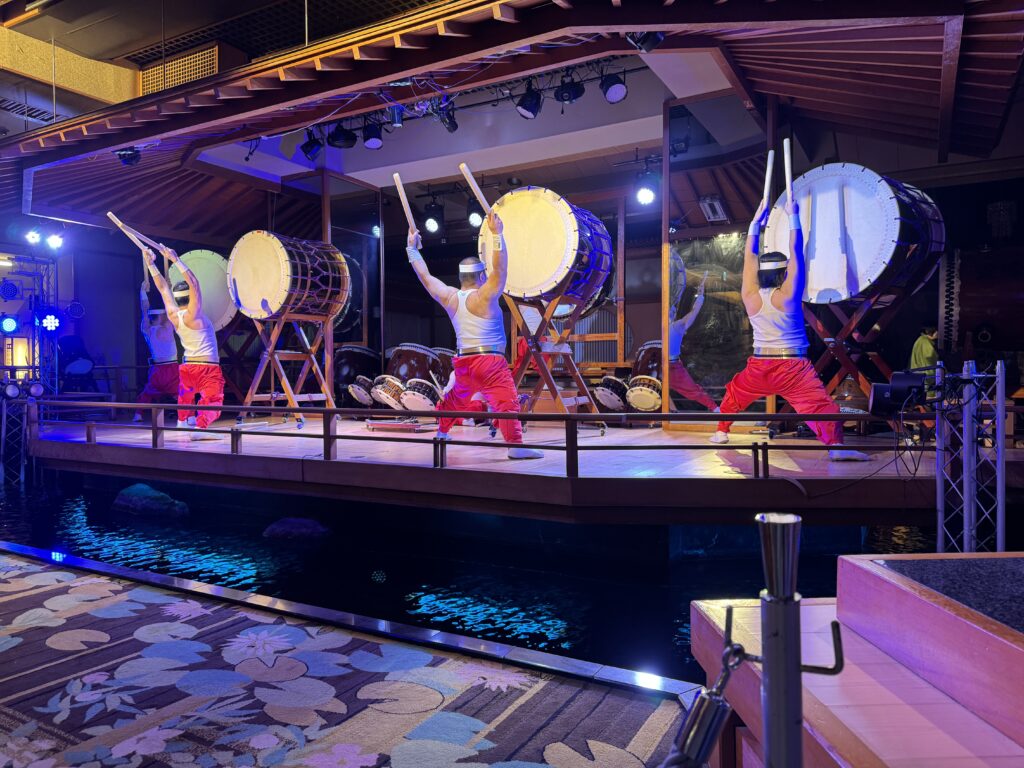
Hotel Kaneyamaen has a stunning garden with water features and beautiful foliage that guests are welcome to explore. Each day of your stay you’ll receive a ticket to redeem at the tea house for complimentary matcha and wagashi, a traditional Japanese sweet. Also within the garden is another small shop that gives complimentary glasses of amezake (sweet rice drink) in the fall and winter and cold green tea in the spring and summer.
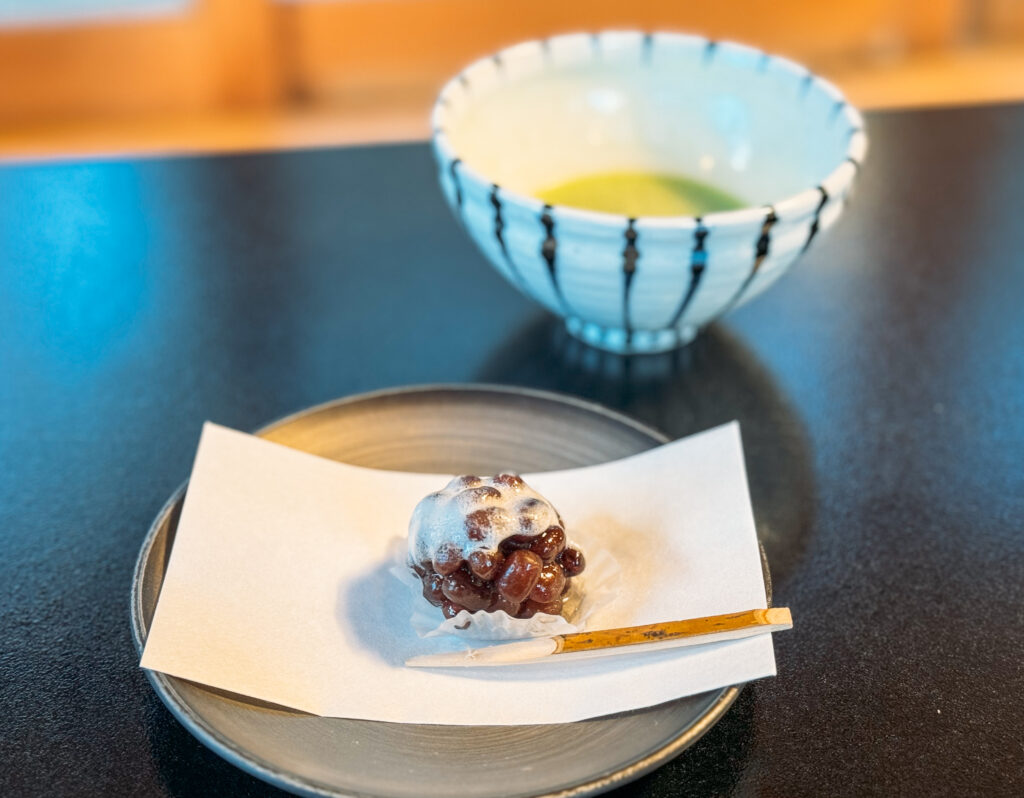
As far as dining options, breakfast and dinner are both included in your room price. Breakfast is buffet style and has a selection of Western and Japanese breakfast items with an emphasis on local foods like hoto, a savory stew with thick noodles and vegetables.
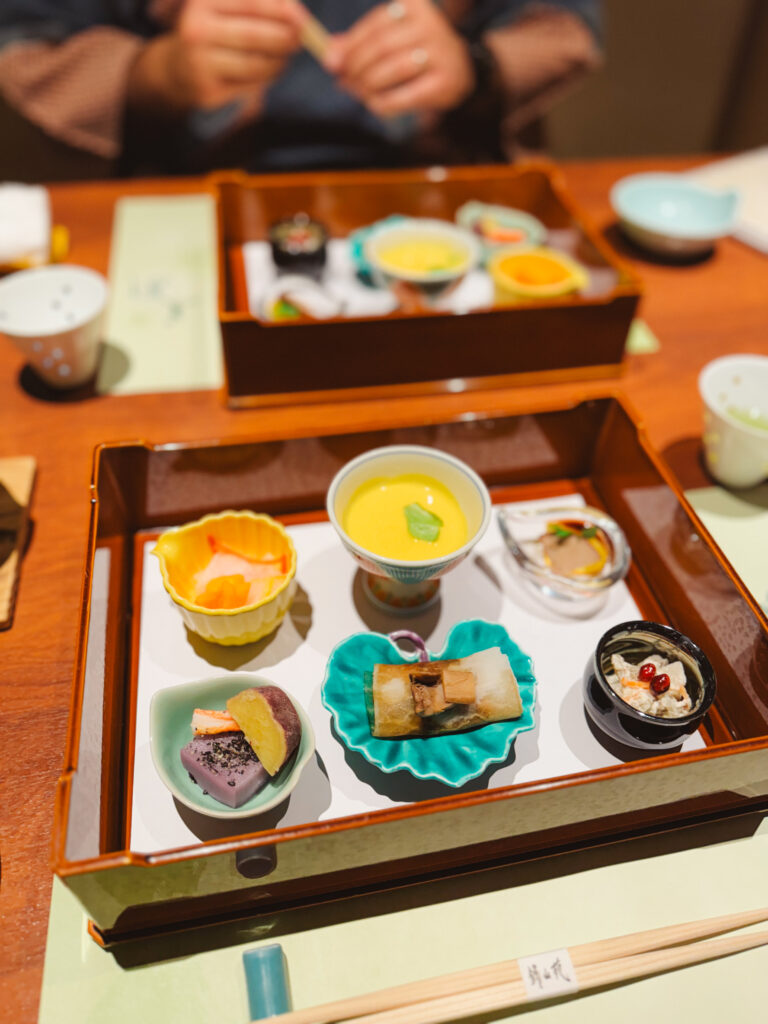
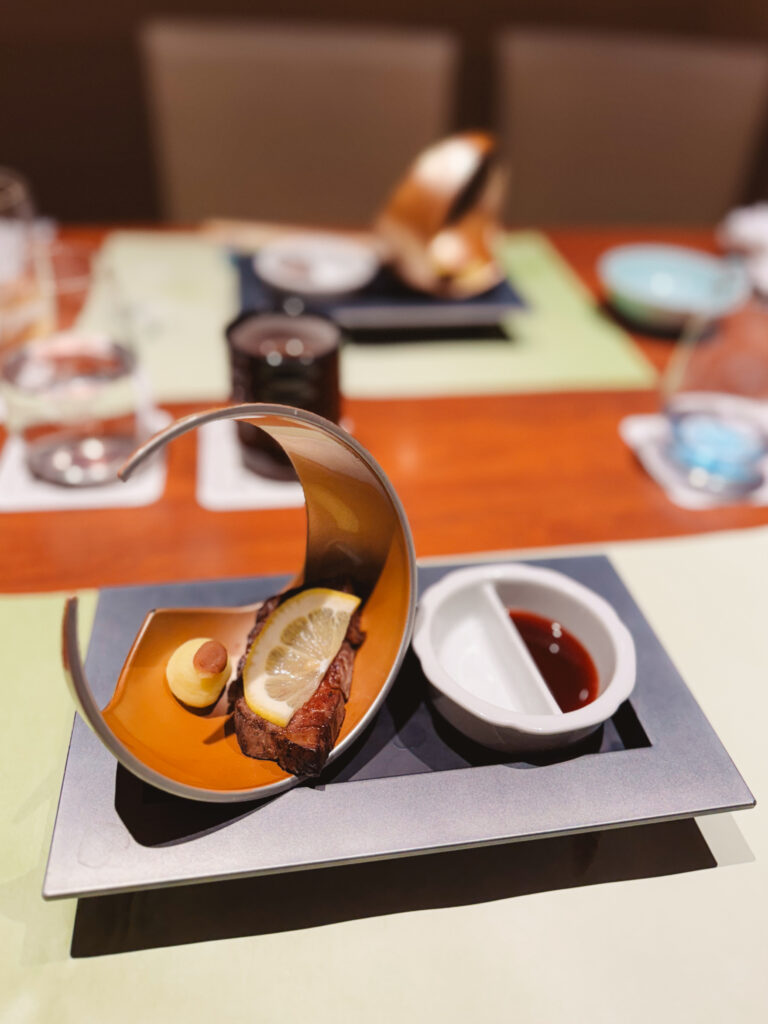
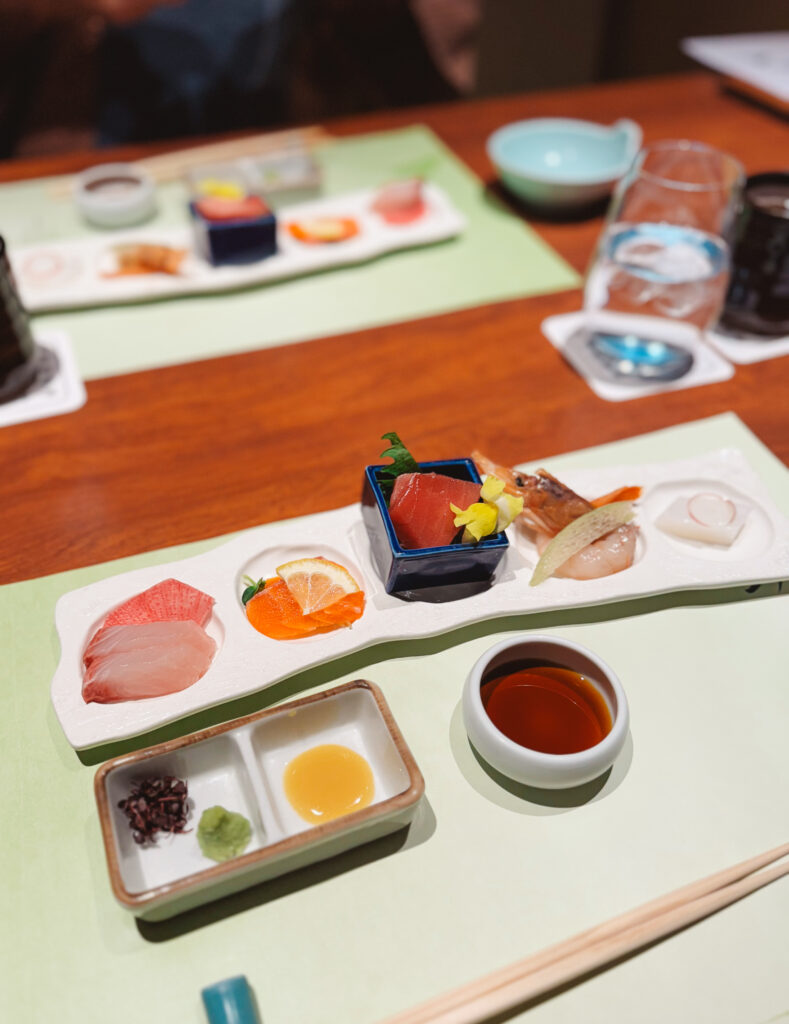
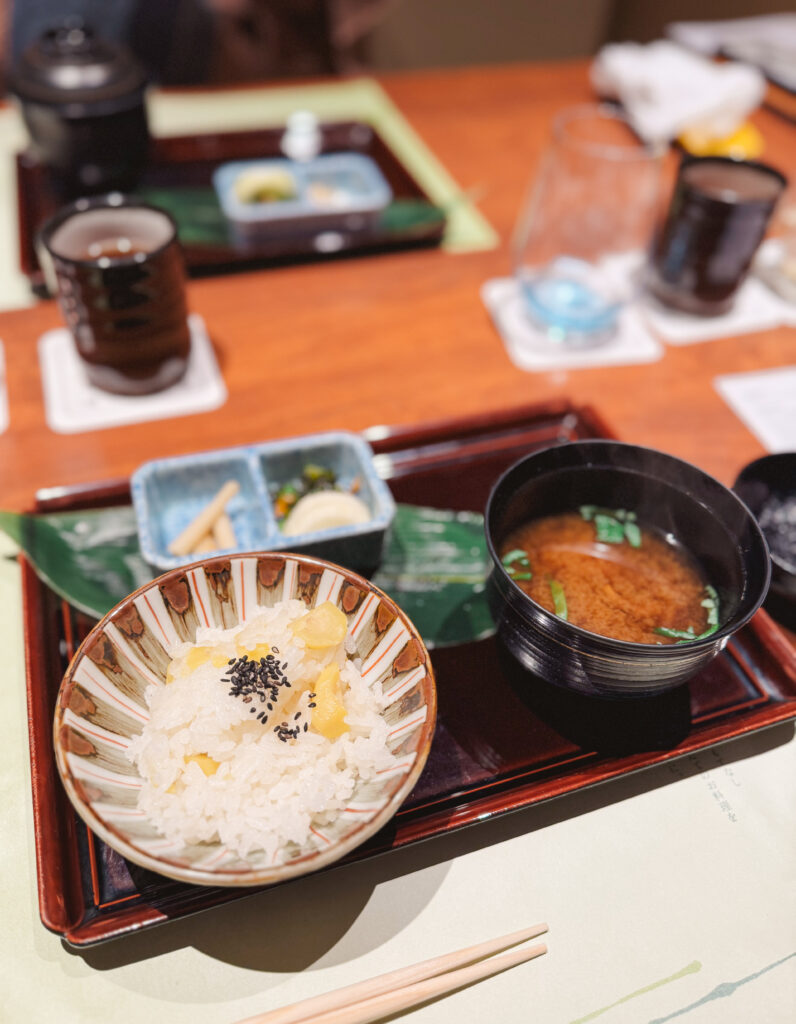
But what about the room? We stayed in the Yuraku Yamabiko-tei Japanese-style room which has a private open-air bath with a Mt. Fuji view! The room is exceptionally spacious and has comfortable futons, and two mini refrigerators – one with items available for purchase for reasonable prices and another to store personal goods. They also have a kotastu table which we cozied up under on the chilly evenings and mornings! Of course, my favorite feature was the private onsen because that Fuji view was UNREAL!
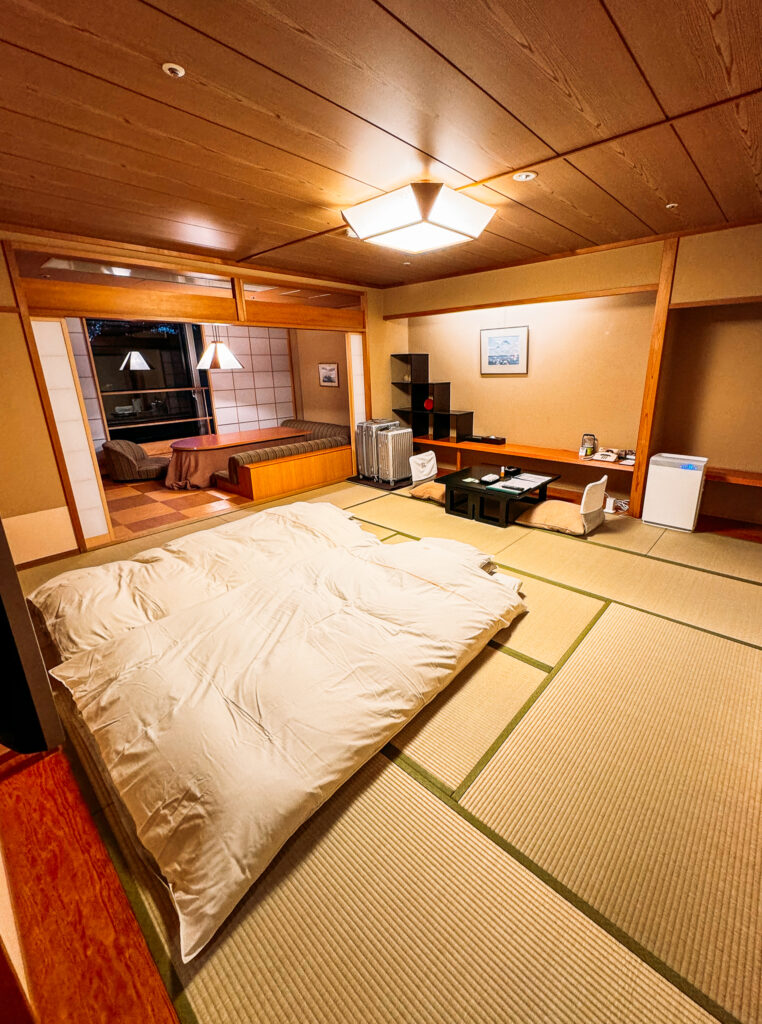

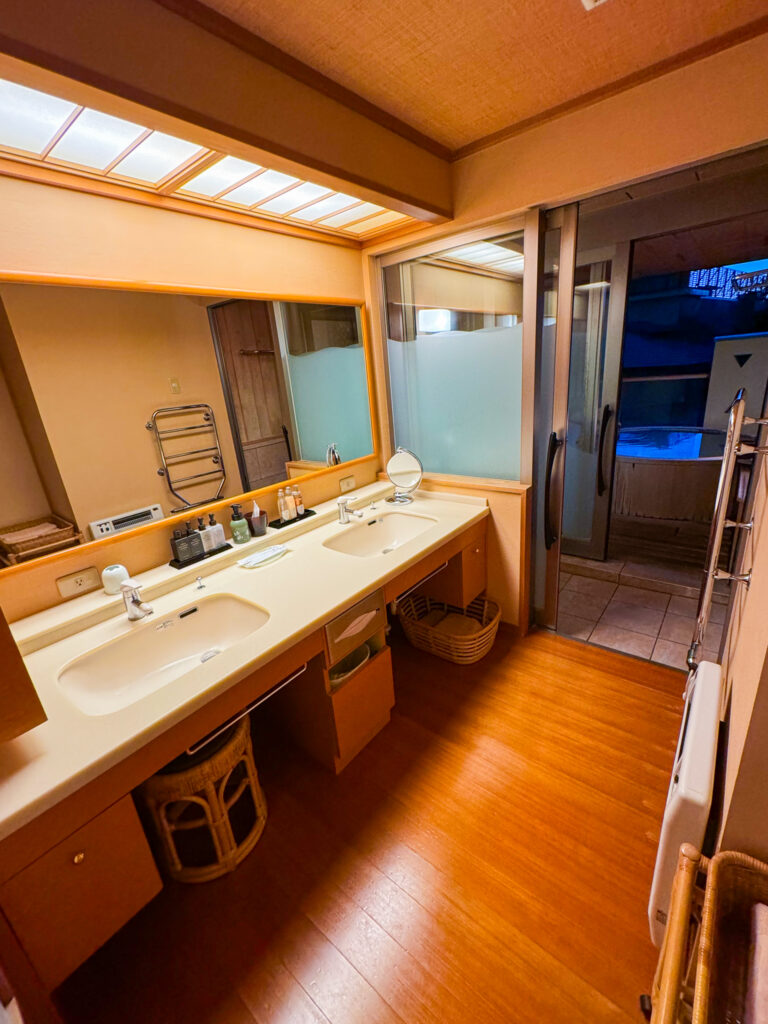
When we stayed at Hotel Kaneyamaen we had a rental car which made our stay here easy but for those that don’t have a car, they do have a shuttle to take you to/from the nearest station. Although this service is for arriving and departing. Therefore this hotel in Fuji isn’t as convenient for those traveling by public transportation.
Things to Do in Fuji Five Lakes
Stay At A Luxury Onsen Ryokan
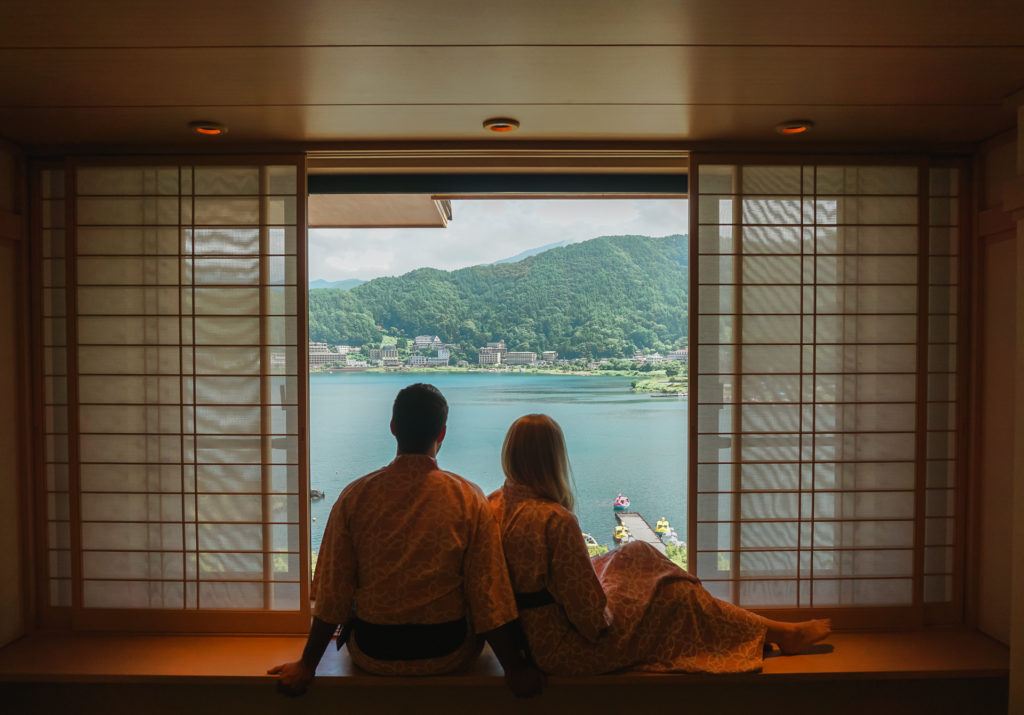
Other than seeing Mount Fuji up close, staying at a luxury onsen ryokan to relax and dine is one of the most popular reasons to visit Fuji. When looking for a luxury ryokan for your Fuji Five Lakes itinerary there are a few factors to consider but two of the most important are the location and view. Many ryokans in the Fuji Five Lakes area offer a view of Mt. Fuji or one of the lakes from your room.
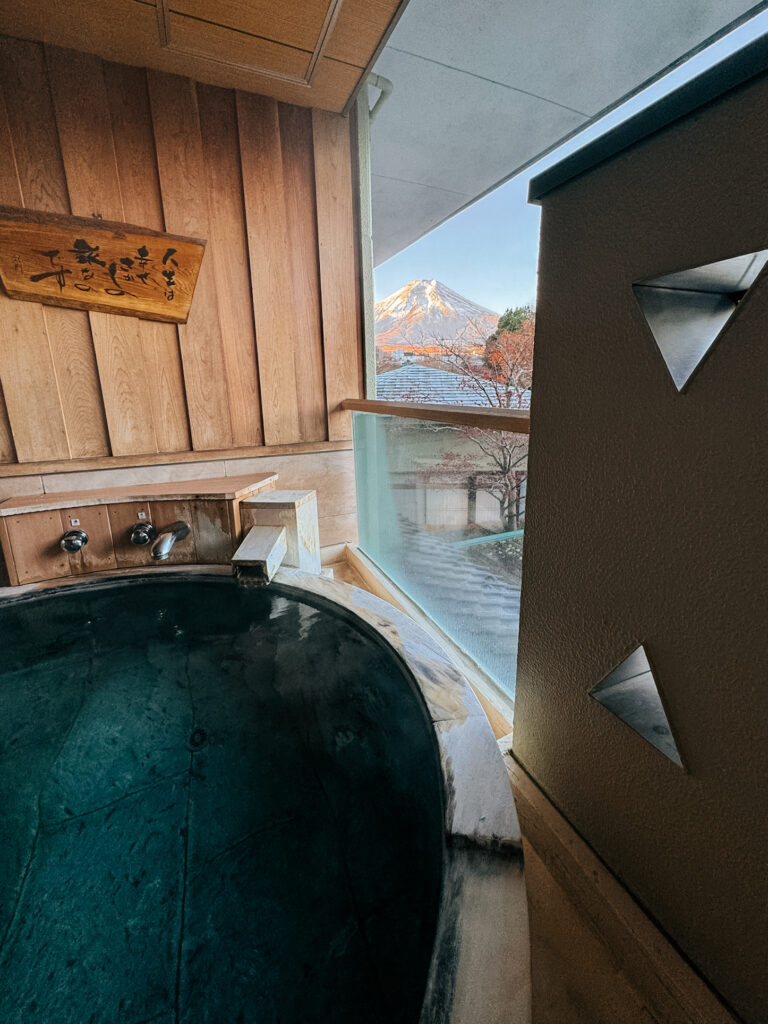
Since you might splurge for a luxury ryokan anyway, make sure you have that extra ambiance. A lot of ryokan also have private onsen in some rooms, or private onsen available by reservation. Regardless of where you decide to stay, make sure it ticks all your boxes!
Look For A Luxury Ryokan in Fuji
Admire the Beauty of Arakura Fuji Sengen Shrine
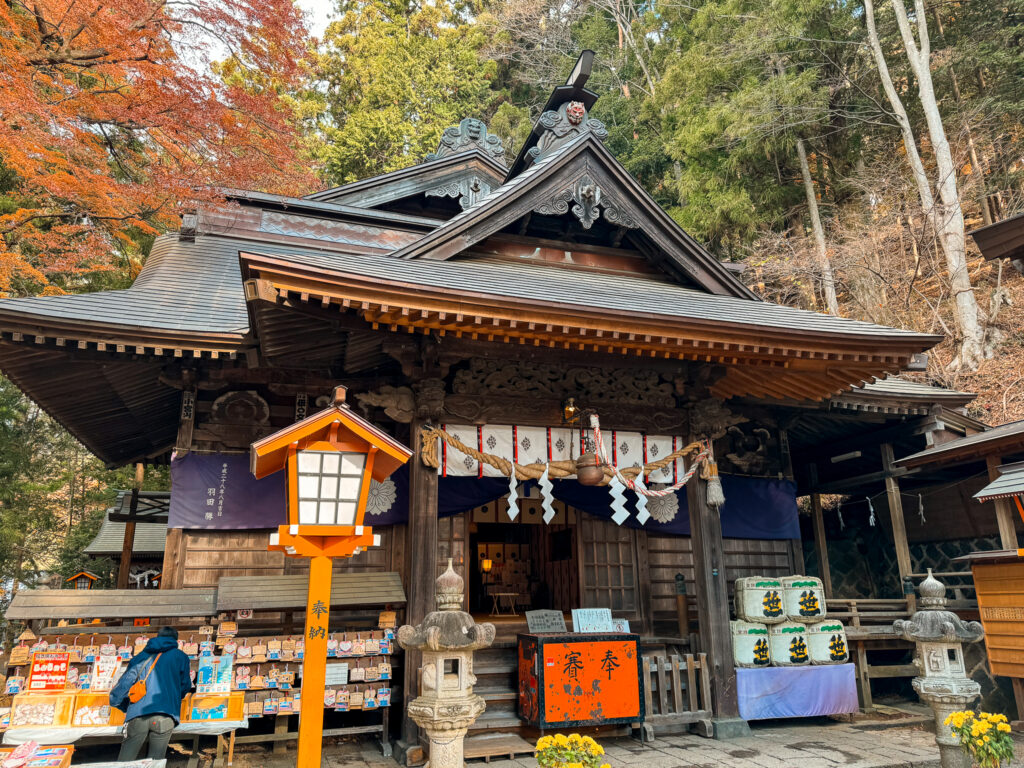
After visiting the Chureito Pagoda take a few minutes to visit Arakura Fuji Sengen Shrine. Even with its many crowds, there is something so serene about it. The shrine is set in a thick forest area along a path of stone lanterns and tall trees. The main hall stands from 1615 where you can see a dancing stage and several artifacts and unique details carved towards the top of the shrine.
Address: 5558 Kamiyoshida, Fujiyoshida, Yamanashi 403-0005, Japan
Climb to the Fuji View at Chureito Pagoda
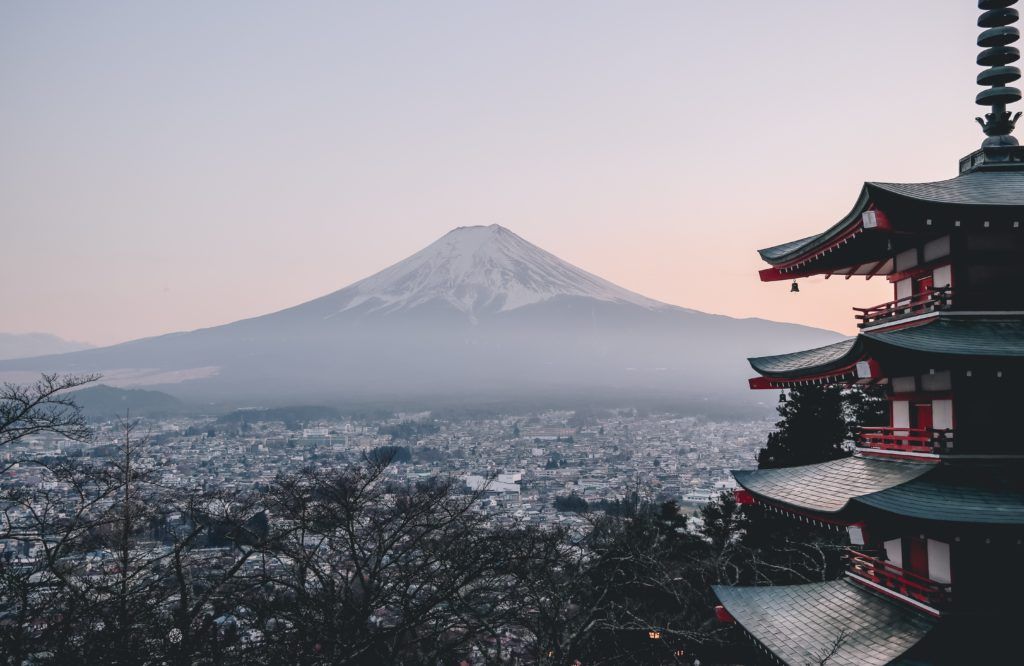
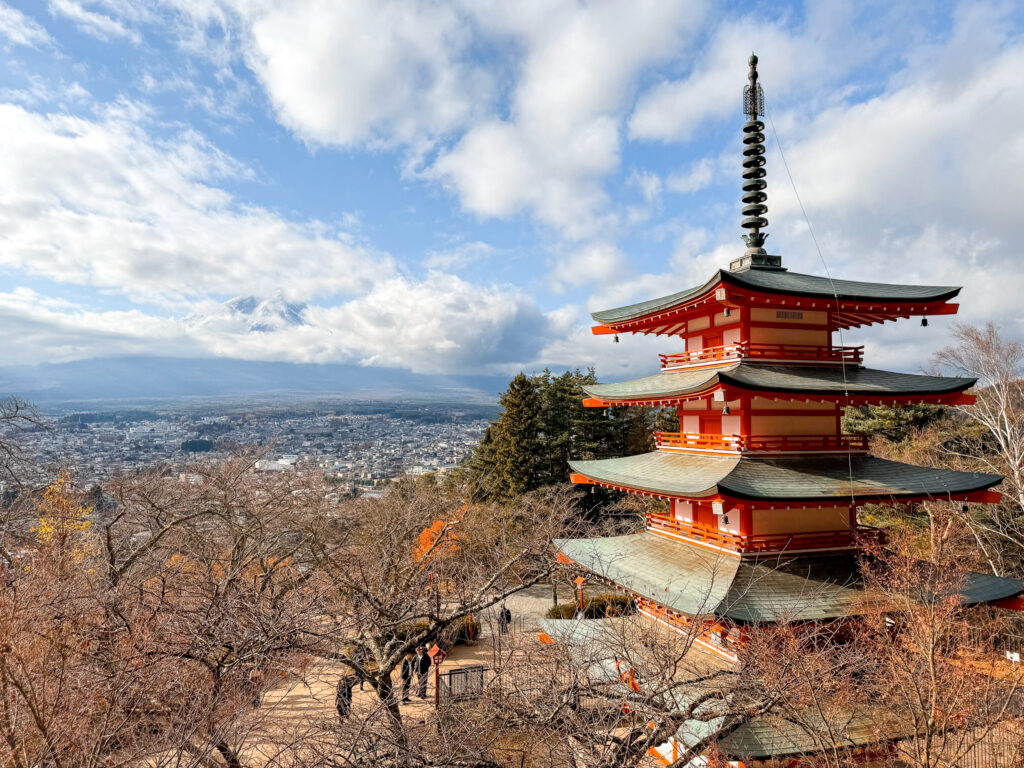
If you’ve looked up photos of Mt. Fuji, the Chureito Pagoda has more than likely popped up in your search. The Chureito Pagoda is a five-story pagoda that is part of the Arakura Sengen Shrine. It is also one of the best Mount Fuji viewing spots, especially during the spring for cherry blossoms or autumn for the gorgeous foliage.
If you plan to visit Chureito Pagoda, it’s best to head there early! It’s one of the most popular attractions on this Fuji Five Lakes itinerary so there are bound to be several tourists visiting. It is also a little bit of a hike to reach the pagoda.
Address: 3353-1 Arakura, Fujiyoshida, Yamanashi 403-0011, Japan
Hours: Open 24 hours, but sunrise to sunset is the best time to visit.
Try Hōtō, Yamanashi Prefecture’s Regional Dish
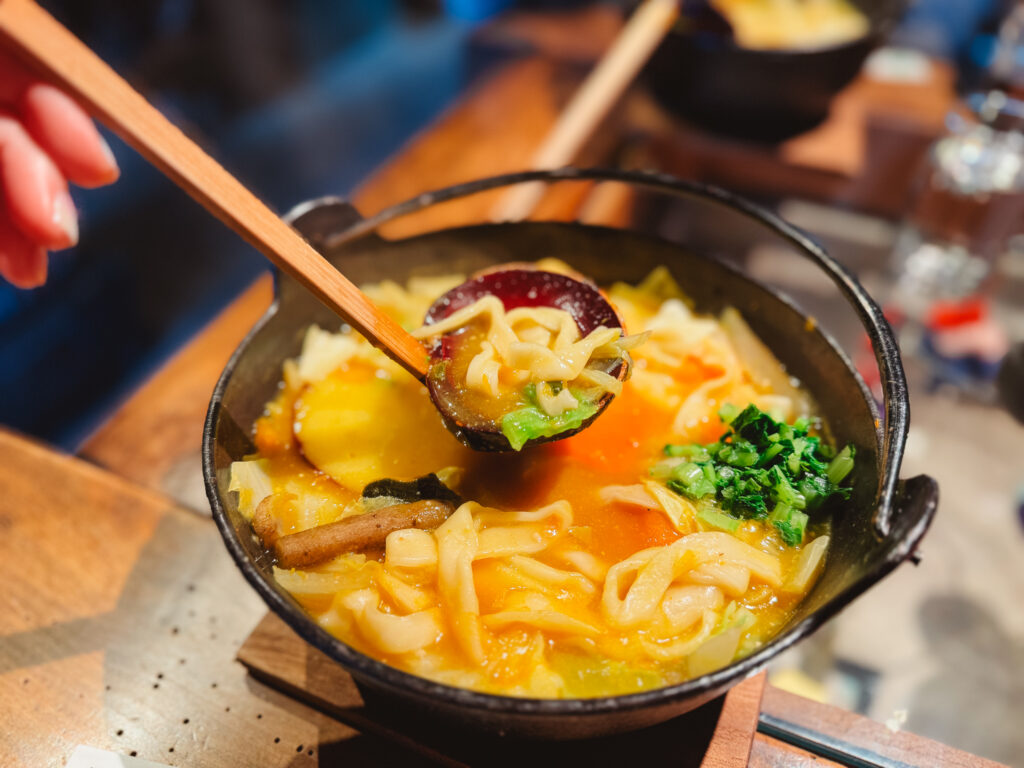
Hōtō is a noodle soup dish that originates from the Yamanashi Prefecture where Fuji is located. It is made with rich, savory miso broth, hearty vegetables, chewy flat noodles, and usually some sort of meat like pork or chicken. Although the noodles resemble thick udon noodles they aren’t typically placed in the same category because they’re made from dumpling dough! This comforting dish feels like a warm hug and is a must-try while in the Fuji Five Lakes area!
Places to Try Hōtō in the Fuji Area:
- Hoto Kikori: This is my favorite hoto spot in Fujiyoshida! It is run by the kindest owner and the decor is very artsy. It will feel like you are hanging out in a friend’s home. Their hoto is made with homemade noodles and they use organic produce from their garden. They also have a vegan hoto option which isn’t very common!
- Hotou Fudo: This hoto restaurant is well-known in the Fuji area and close to Kawaguchiko Station.
- Hoto Tempura Wakana: This restaurant has hoto, tempura, soba, and other dishes to enjoy.
Ride the Thrilling Rollercoasters at Fuji-Q Highland
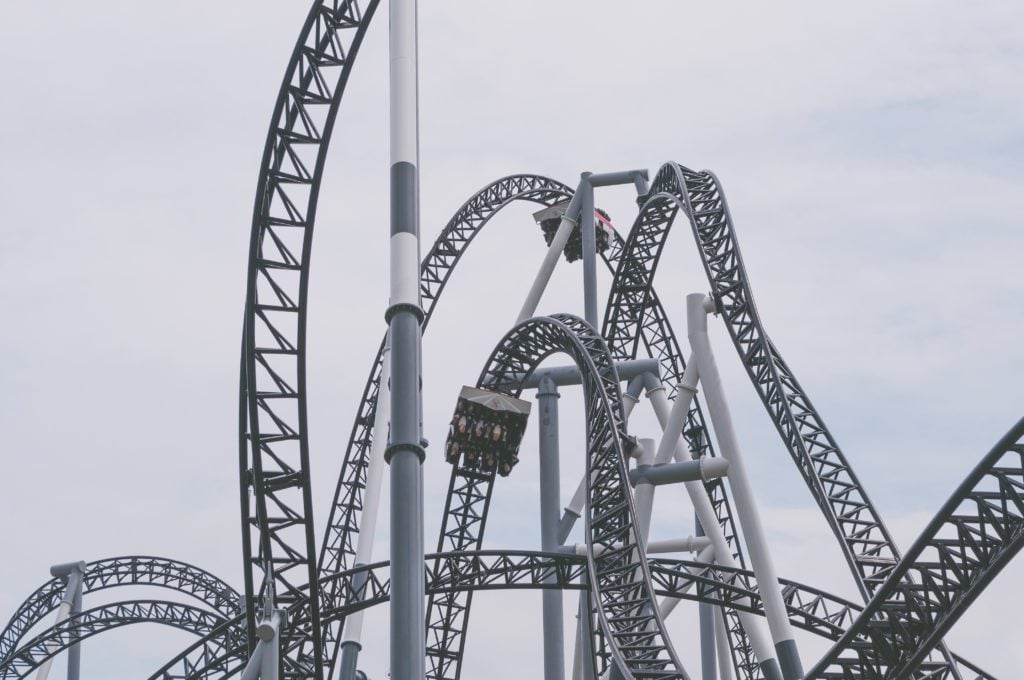
For thrill-seekers, Fuji-Q Highland is a popular amusement park that has excellent roller coasters – think Guinness World Record-breaking roller coasters. Considering it’s at the base of Mount Fuji, you can even get a fabulous view of the mountain while on a ride! Although there are several thrilling rides at Fuji-Q Highland, there are also leisurely and kid-friendly rides in the park.
Address: 5 Chome-6-1 Shinnishihara, Fujiyoshida, Yamanashi 403-0017, Japan
Hours: Monday 9am-5pm, Tuesday-Friday 9:30am-5pm, Saturday & Sunday 9am-6pm (hours may vary based on season and holidays)
Cost: 5,800 yen for an unlimited ride, day pass
Relax at Fujiyama Onsen’s Public Hot Spring
Although Fuji isn’t like the town of Kinosaki Onsen where you can “hot spring hop,” Fujiyama Onsen is a public hot spring you can visit in the Fuji Five Lakes area that is just outside Fuji-Q Highland Park. In addition to relaxing in the hot springs, there are also other spa treatments available such as massage, sauna, and bedrock baths.
Address: 4 Chome-17-1 Shinnishihara, Fujiyoshida, Yamanashi 403-0017, Japan
Hours: 6am-8:30am, 10am-10pm daily
Cost: 1,500 yen (weekdays), 1,800 yen (weekends and holidays)
READ MORE: 5-Day Tokyo Itinerary
Try Kaiseki-style Dining




If staying at a luxury ryokan we highly recommend trying kaiseki dining at your ryokan if it is offered. Kaiseki is a traditional, multi-course Japanese dinner that has a variety of seasonal ingredients elegantly prepared on small plates. It’s an extremely special and unique thing to enjoy while in Japan and is commonly offered at a ryokan as part of your stay or available to add as an additional package.
Take A Ride on the Mt. Fuji Panoramic Ropeway
The Mt. Fuji Panoramic Ropeway is a short 400m ride from Lake Kawaguchiko to a viewing platform on Mount Tenjo. Once you’ve reached the viewing platform you can see a panoramic view of Mt. Fuji and the Kawaguchiko area. Because of the view it offers, this attraction on our Mt. Fuji itinerary can get crowded so we recommend visiting early or in the last part of the day.
Address: 1163-1 Azagawa, Fujikawaguchiko, Minamitsuru District, Yamanashi 401-0303, Japan
Hours: 9:30am-4:30pm daily
Cost: Round Trip: 900 yen/adult, 450 yen/child, One-Way: 500 yen/adult, 250 yen/child, Free with Fuji Hakone Pass
Visit Each of the Fuji Five Lakes
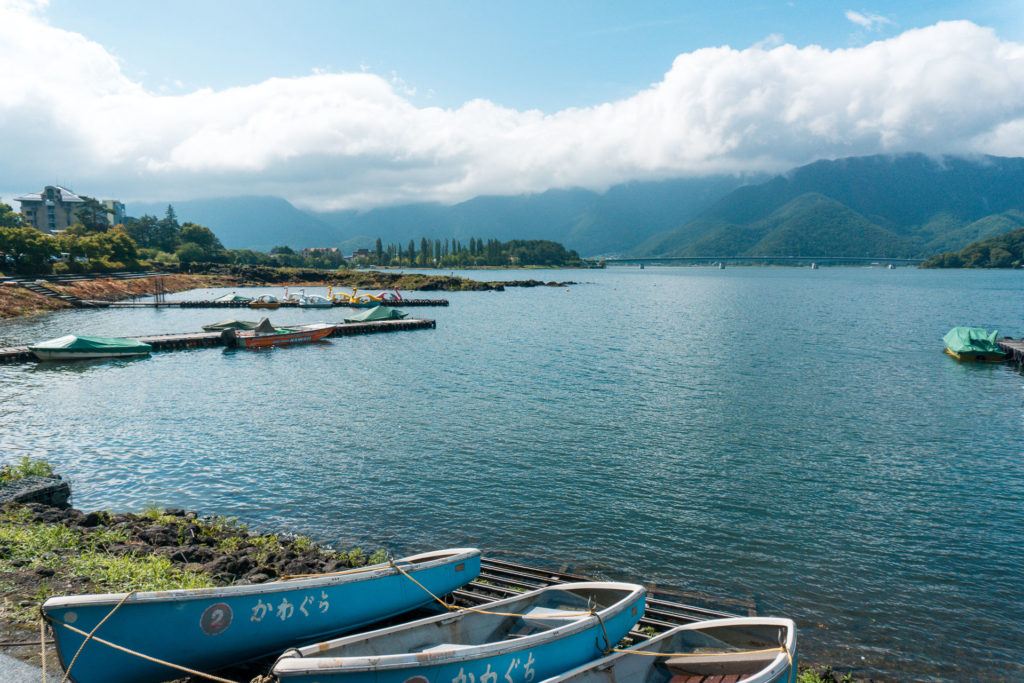
During our Fuji Five Lakes itinerary, we spent most of our time near Lake Kawaguchiko. Lake Kawaguchiko is one of the Fuji Five Lakes and is the easiest to visit by public transportation. It is also the most developed so this lake is a great place to grab something to eat for lunch or a lavender ice cream cone for a sweet treat!
The other four lakes are Lake Yamanakako, the largest of the five lakes, Lake Shojiko, the smallest yet deepest and least developed, Lake Motosu, which is featured on the 1000 yen note, and Lake Saiko, which is west of Kawaguchiko. If you have a lot of time we recommend visiting each one because they all are vastly different from each other!
Book A Tour of the Fuji Five Lakes
Walk Through Flower Fields at Yamanakako Hananomiyako Park
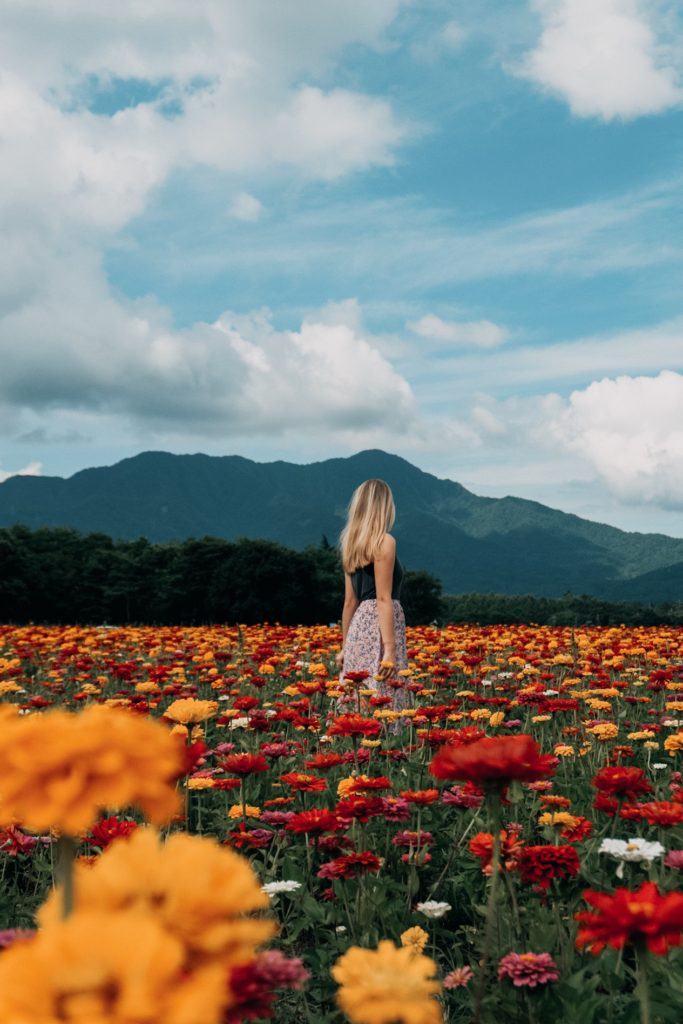
Other than catching a glimpse of Mt. Fuji and staying in an onsen ryokan, Yamanakako Hananomiyako Park is my favorite thing on this Fuji Five Lakes itinerary. I’m a sucker when it comes to flower fields and these were some of the best.
I think the only thing that would have made it even better was seeing Mt. Fuji in all its glory with the flowers in the view too! I guess we’ll have to go back when it’s prime viewing time. Regardless, the scenery at Yamanakako Hananomiyako Park was so peaceful we never wanted to leave!
The flowers are changed by the seasons so no matter when you visit, there should be something beautiful to witness. If you’d like to visit a few other flower fields in the area you can also go to Oishi Park near Lake Kawaguchiko and Fuji Shiba-sakura near Lake Motosu.
Address: 1650 Yamanaka, Yamanakako, Minamitsuru District, Yamanashi 401-0501, Japan
Hours: 9am-4:30pm daily (hours may vary based on season and holidays)
Cost: 500 yen
Learn About Tsujigahana & Itchiku Kubota’s Stunning Kimonos
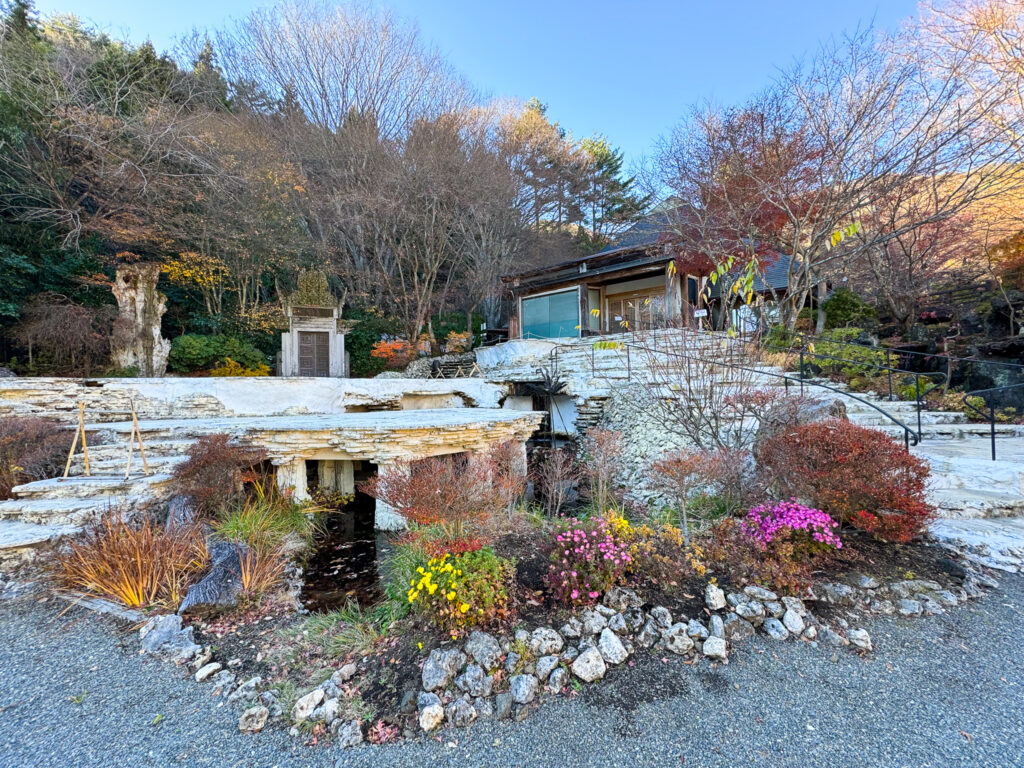
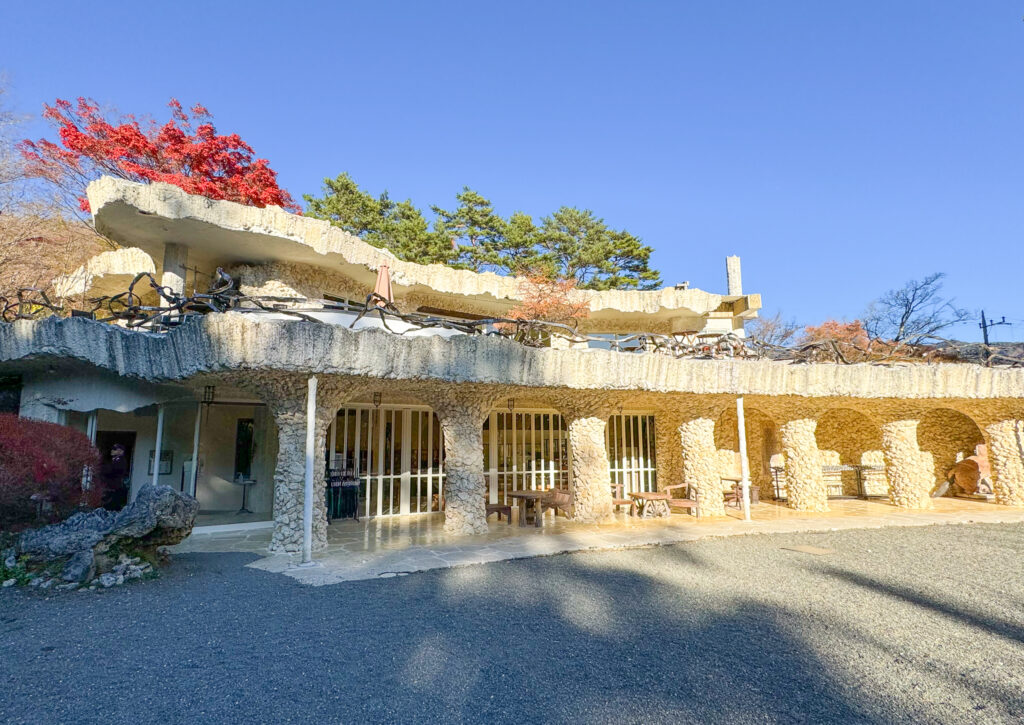
The Itchiku Kubota Art Museum is one of my favorite things to do in Fuji. The museum is located in his former residence which was largely influenced by Antoni Gaudi’s architecture in the most picturesque setting surrounded by beautiful trees.
At age 20, Itchiku Kubota became mesmerized by tsujigahana, a textile dyeing technique that was largely used during the Muromachi era but sadly disappeared at the start of the Edo Era. Itchiku Kubota saw a piece of fabric with this dyeing technique in a museum and decided to dedicate his life to recreating this process.
It wasn’t until he was in his 60s that he accomplished this feat. He then began using tsujigahana to create the most stunning, vibrantly colored kimonos I’ve ever seen. Kubota was largely influenced by nature which you’ll see reflected in each of his kimono designs. Photos aren’t allowed in the museum but take my word for it, they will leave you speechless.
While visiting the museum make sure you take time to watch the short documentary which tells you more about Kubota’s life, the tsujigahana dyeing technique, and Kubota’s kimonos. After, visit the tea house to enjoy some matcha and wagashi (Japanese sweets) and stop by the gift shop. We bought a book there that features Kubota’s kimonos and a tenugui (Japanese towel) that has one of his designs.
Location: 2255 Kawaguchi, Fujikawaguchiko, Minamitsuru District, Yamanashi 401-0304, Japan // MAP
Cost: 1,500 yen
Enjoy the Beauty of Yagizaki Park
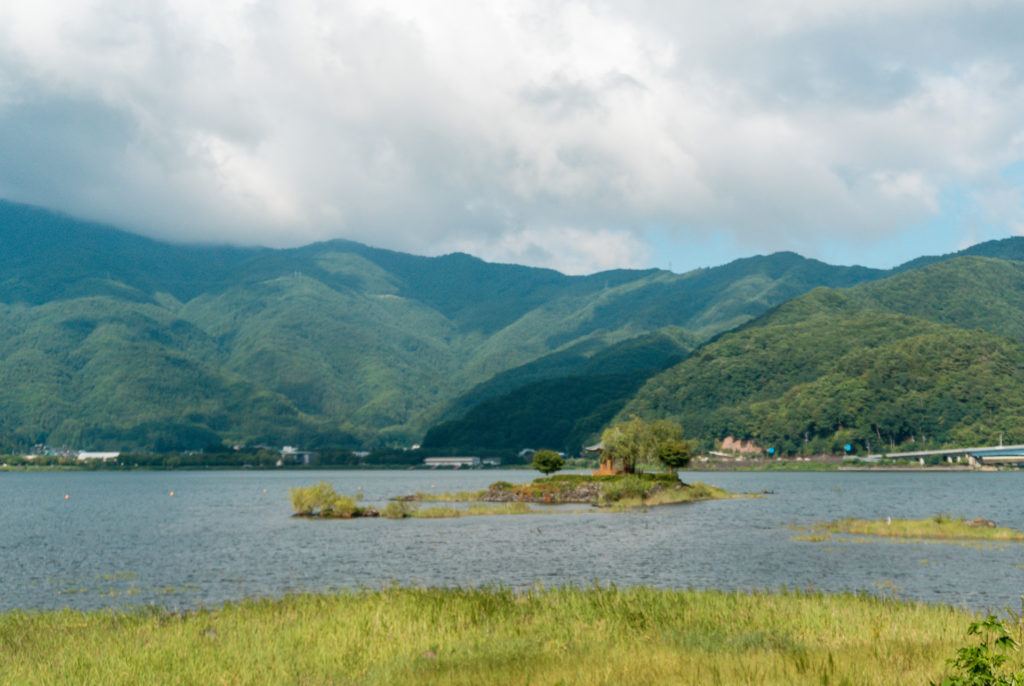
Yagizaki Park is a large, very photogenic park. The flower fields will enchant you with a light, floral aroma that fills the air and there is a stunning view of Mt. Fuji and Kawaguchiko Lake.
Other than these factors, the reason we wanted to mention it in our Fuji Five Lakes itinerary is due to its walkable distance and the size of the park. We grabbed some lunch at a local grocery store and took it by this park to enjoy a picnic. It honestly felt like we were sitting in a poem due to the natural beauty that surrounded us.
Address: Japan, 〒401-0302 Yamanashi, Minamitsuru District, Fujikawaguchiko, Kodachi, 897番地の1 先
Hours: 24 hours
Cost: Free
READ MORE: The Best Day Trips From Tokyo
Take A Journey to Fuji 5th Station
The Fuji 5th Station is 2,300 meters above sea level and is one of the four trails you can take to get to the summit of Mt. Fuji (more on this in a moment!). But if you aren’t interested in climbing Fuji 5th Station is also one of the most visited spots for viewing Mt. Fuji and taking photos!
Address: Narusawa, Minamitsuru District, Yamanashi 401-0320, Japan
Climb Mount Fuji
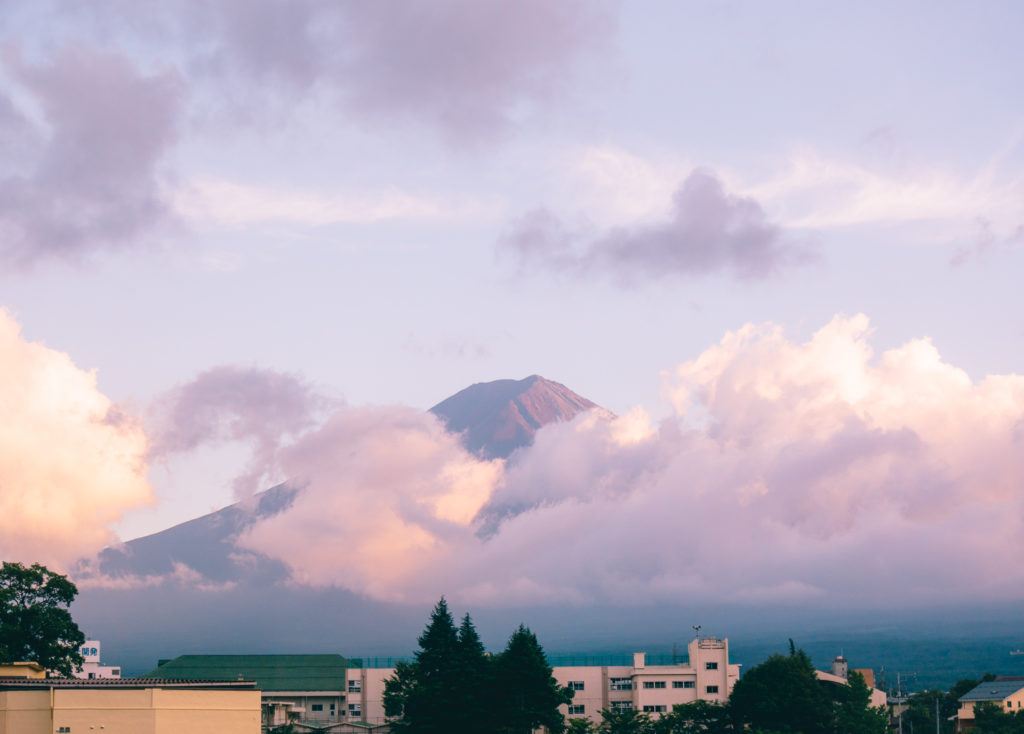
Considering most mountain hikes, Mt. Fuji is a relatively easy one. But at 12,388 ft, Japan’s highest mountain does have significant elevation change and steep inclines. If you’ve prepared physically and have the proper gear, this is easily an item to consider adding to your Japan bucket list.
If you do decide to climb Mt. Fuji, also make sure you allow yourself an extra day or two in the Fuji Five Lakes area and book a mountain hut in advance! There are limited spots available. The climbing season for Mt. Fuji is from Early July to mid-September due to the lack of snow and mild temperatures.
Mt. Fuji Access Points
Yoshida Trail (Yellow)
- Start at Fuji-Subaru 5th Station (2,300m above sea level)
- Trail Length: 12.7km round-trip
- Ascent: 5-7 hours, Descent: 3-5 hours
- Great for beginners. Most developed and most popular/congested.
Subashiri Trail (Red)
- Start at Subashiri Trail 5th Station (2,000m above sea level)
- Trail Length: 11.7km round-trip
- Ascent: 5-7 hours, Descent: 2.5-4 hours
- For more experienced hikers. A little developed.
Gotemba Trail (Green)
- Start at Gotemba Trail New 5th Station (1,450m above sea level)
- Trail Length: 21km round-trip
- Ascent: 6-8 hours, Descent: 3-5 hours
- This is the most difficult trail. It is best for veteran hikers.
Fujinomiya Trail (Blue)
- Start at Fujinomiya Trail 5th Station (2,400m above sea level)
- Trail Legnth: 7.6km round-trip
- Ascent: 4-6 hours, Descent: 2-4 hours
- Great for beginners. It is the shortest route to the top of Mt. Fuji and second most popular trail.
The Fuji Five Lakes area is a magical place that is worth adding to any Japan itinerary. I hope you can go enjoy the local cuisine, experience one of Fuji’s fine ryokan, soak in an onsen, and of course, enjoy stunning views of Mt. Fuji!
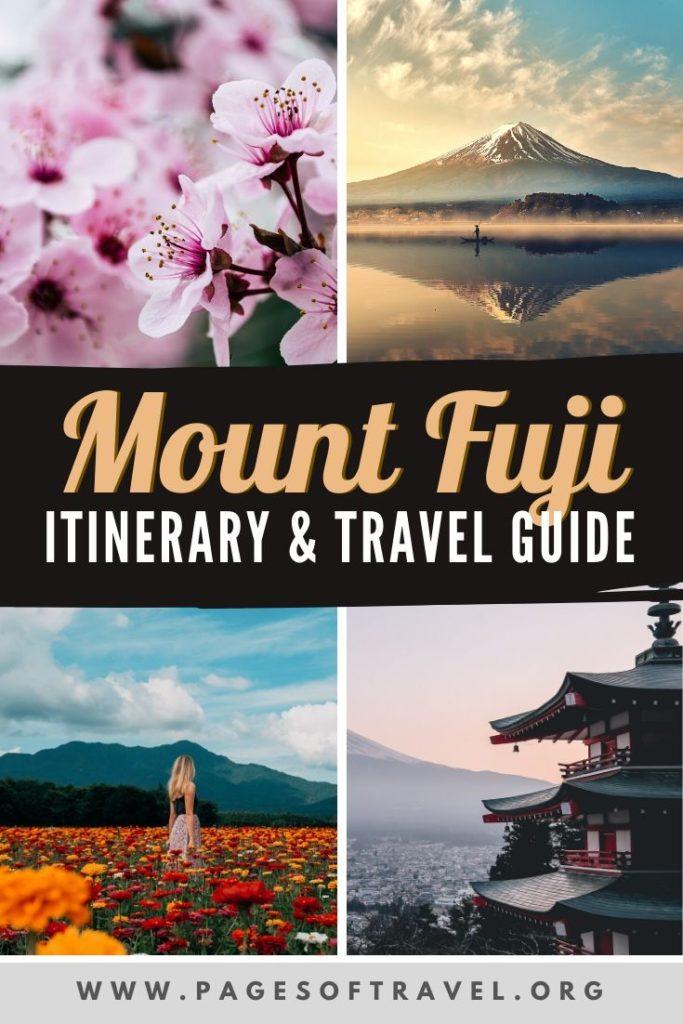
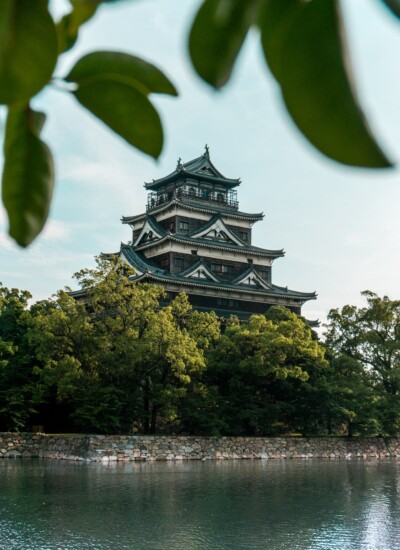


Comments & Reviews
Brooke says
This is super helpful, thank you for all the info and how to get to the different lakes, thanks again!